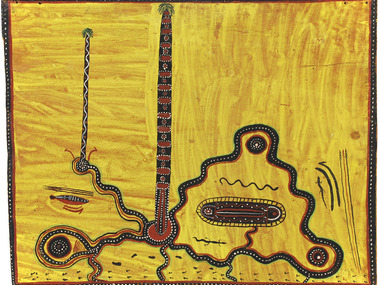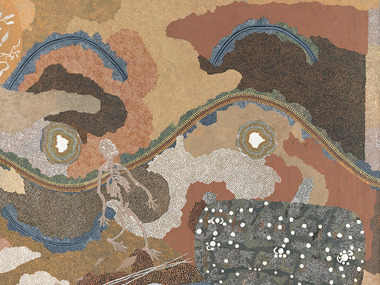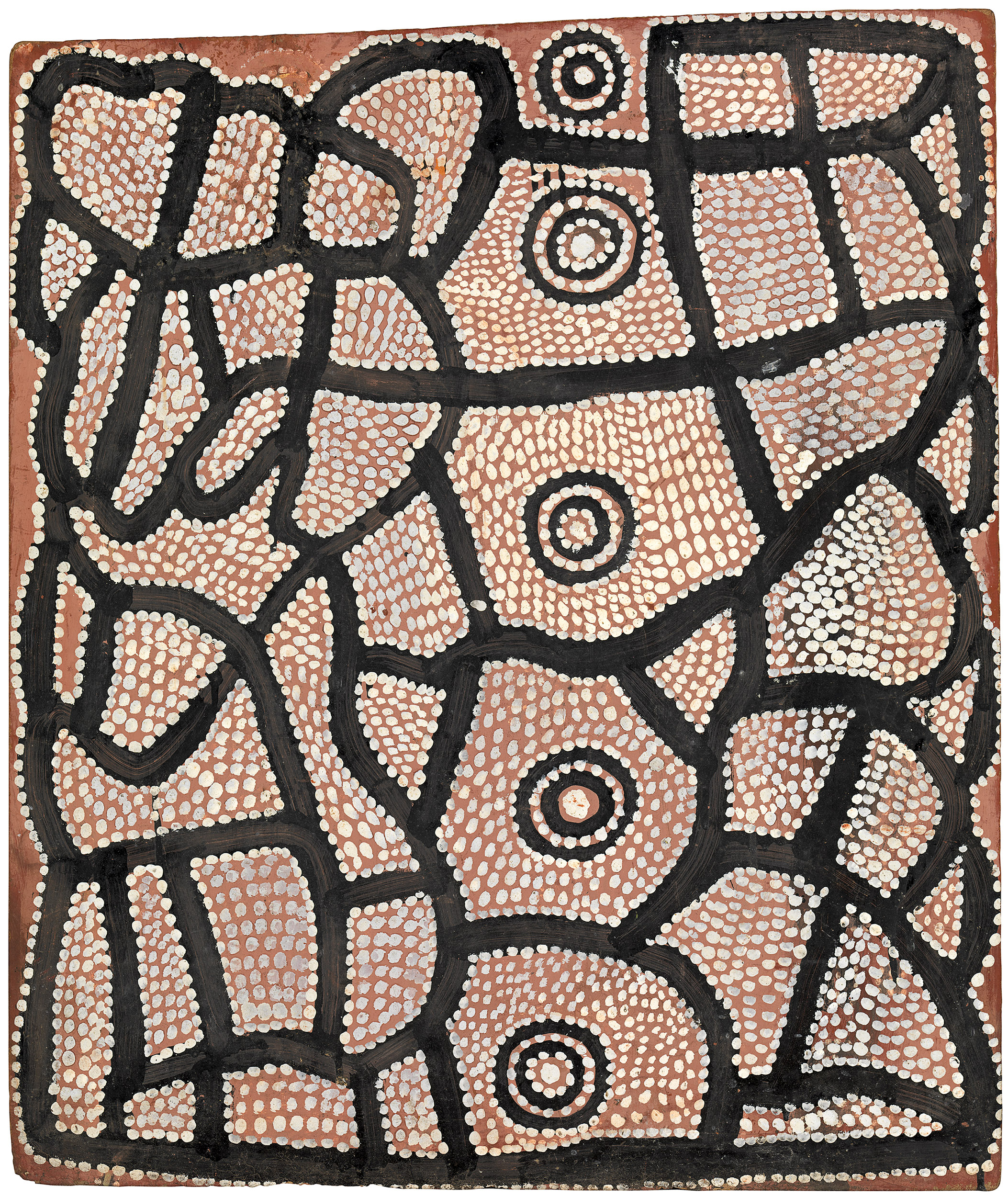TJUKURRTJANU – THE ORIGINS OF WESTERN DESERT ART

'The Ceremony at Waru' 1971 by Kaapa Mbitjana Tampitjinpa. Watercolour on board 61 x 137 cms
Posted by Jeremy Eccles | 18.11.11
Gallery: National Gallery of Victoria
Dates:
01.10.11
: 12.02.12
There's a tremendous tension around at the moment between those who want to show Aboriginal art as 'great contemporary art' and those who want to try to understand its mysteries and complexities. And this is sadly all-too-apparent in the yawning gaps between intention and result in the big, important Tjukurrtjanu – Origins of Western Desert Art show that's recently opened at the NGV in Melbourne.
The preparations took three years and were all-embracing. Eighteen of the twenty-five artists recognised by Vivien Johnson in Lives of the Papunya Tula Artists as gathering in the Great Painting Room at Papunya in 1971 and 72 were selected, their works cleared for showing by 'contemporary cultural custodians', and are presented as individuals. Two late starters – Freddy West Tjakamarra and Ronnie Tjampitjinpa are added – presumably for their longevity; and seven of the founders are missing – again presumably (there's no justification for the selections) because of a failure to endure or produce a body of works that was aesthetically distinctive to European eyes.
One does question the absence of David Corby Tjapaltjarri – who was also excluded from the last Papunya Tula compilation – Genesis and Genius, at the AGNSW in 2000. He may have died young, but he'd represented the new painting movement in several international outings, and painted an exquisite, spacey board in 1972 (Untitled) that is in the seminal collection of the NT's Museum and Art Gallery. Perhaps that institution's mysterious refusal to lend its works to the NGV played a part in Corby's absence?
But having gone to three years' effort – with Philip Batty of the Melbourne Museum coming aboard to add some its early artefacts so that viewers could know that the Papunya boards didn't emerge out of thin air, but were part of a ceremonial continuity – the presentation in the Federation Square gallery by curator Judith Ryan is, frankly, lacklustre.
Far too much effort is demanded of the viewer when pacing long walls to link together the works of that wall's chosen artist – a simple, hand-held biography could have made all the difference. For it wuld not only have brought that individual alive, but added ethnographic hints to explain which Dreamings dominated that man's life, what geography was at the forefront of his mind, and what role he played in the mutation of the Papunya iconography from the secret/sacred of the so-called 'School of Kaapa' – the daring Anmatyerr artists who'd had enough white contact to feel free to mediate between the hidden world of tribal Australia and the non-Aboriginal need to make sense of what they were seeing – to the over-dotted disguise that then lead into a Pintupi preference for restricting their art to the abstract mosaics describing Tingarri subject-matter.
What emerges, sadly, is a sense of aesthetic inconsistency in most of the artists' work. Exceptions are certainly there – Walter Tjampitjinpa stands out for the sheer quality and variety of his Water Dreamings; and Shorty Lungkata emerges as a star 'artist' – described by anthropologist Fred Myers as “inhabiting his pictures” via a “sense of performance, the haptic of movement in the play and politics of ceremony”.
But it seemed clear to me from the exhibition that other painters like Uta Uta Tjangala and Mick Namarari – long a hero of mine – really only flowered as artists when they could paint on canvas in the later 70s and 80s. Which may have been the reason for extending the exhibition from the early boards – the Origins – into Namarari's op art Bandicoot Dreaming from 1994, to Ronnie Tjampitjinpa's pure patterning from '91, and, above all, to the Tim Leura/Clifford Possum Tjapaltjarri half brothers' collaboration, Spirit Dreaming through Napperby Country, 1980.
Viewers might just wonder why this refined, intentionally post-Modernist work from 8 years after the boards is the culmination of an exhibition called Origins? As for so many of the resonances in this exhibition, you have to turn to the brilliant catalogue to get full benefit. There, John Kean, an early PTA coordinator takes the Possum Brothers from early works constrained by the size of boards to canvases of “breathtaking scope and sophistication” like the 6.7 metre Napperby Country with its self-referential areas repeating Tim Leura's earlier works, it's bold central Possum Dreaming story and its unique appearance of a skeletal figure. Geoffrey Bardon, who'd commissioned the work, jumped to the conclusion that this was a Death Spirit. But Kean makes the fascinating case that this is instead an ancestor “dissolving into the Dreaming”, which of course is a continuous event, not the full-stop of death in Anmatyerr thinking.
Kean isn't the only writer in the catalogue to 'have a go' at Geoffrey Bardon. Fred Myers is also at pains to stress that far too many Bardon interpretations of paintings – especially those that ended up in the Wilkerson Collection that toured the US as Icons of the Desert – were given stories based on local happenstance in Papunya, like a flood. Instead, Myers is confident from his time spent with the painters as they began to move from Papunya into outstations, that the boards invariably told stories of their birthplaces and inherited country, showing the physical properties and ceremonial associations of those places. Yet Bardon's notes (and those of the other entrepreneur in those early days, Pat Hogan at the Stuart Art Centre in Alice) made few references to place.
Myers' critique brings us back to the tensions around the presentation of Aboriginal art today. For, while the NGV is clearly running a mile from the ethnography of these Original works, the anthropologist believes “that might provide us with the necessary knowledge to understand the painters as people with values and orientations, with histories of their own, (without which knowledge we can't) organise a meaningful archive of any painter's body of work. We can only understand the paintings in their singularities when we can locate them in the foundational system of Indigenous order”.
To put it bluntly, the NGV's layout of 20 artists' work without any explanation apart from name and number is quite counter-productive.
Interestingly, the curator who took Emily Kngwarreye to the world, Margo Neale of the National Museum, tackled that very issue on Radio National the other night, saying, “But the artists are painting in order to share their stories”. So it's pretty daft to go to the extreme of dissociating both the artist's history and the story from his (or her) paintings.
In many ways it's the pressure to find an international audience for Aboriginal art in American, European and Asian institutions that is motivating this denial of meaning. Remember the Frankfurt Art Fair rejecting it as 'folk art' in the '90s. Yet a recent piece by Nicolas Rothwell in The Australian points out that “Aboriginal art is Australia's treasure before it is the world's. It springs from this continent; it relates to the rhythms of the Australian landscape; a lot of looking is needed even to begin to see the art from the inside”. And he posits the current Chinese tour of art from the uniquely uncommercial community of Warburton – Tu Di : Chen Ti (Our Land : Our Body) – as finding 85,000 visitors in just two weeks in Shanghai by playing up comparisons with China's “ancient, code-rich culture”.
Artworks were presented in “an installation that acknowledges Western Desert people and their world; genealogies, narrative text, photographs taken by indigenous schoolchildren, and a 20 channel immersive sound and data installation are important parts of the exhibition space. Meaningful translation in wall texts, captions and documentation has been a priority to reach Chinese audiences”, says the community's press release.
If it's all good enough for the Chinese, I wonder why we can't have it in Melbourne???
And surely it'll be expected when Tjukurrtjanu moves on to the Musee du quai Branly in Paris next year, a museum with its roots absolutely in ethnography.
URL: www.ngv.vic.gov.au
Share this:
»  del.icio.us
»
del.icio.us
»  Digg it
»
Digg it
»  reddit
»
reddit
»  Google
»
Google
»  StumbleUpon
»
StumbleUpon
»  Technorati
»
Technorati
»  Facebook
Facebook
Contact Details
Gallery: National Gallery of Victoria
Contact: Judith Ryan
Email: enquiries@ngv.vic.gov.au
Telephone: +61 3 8620 2222
Address: NGV Australia Federation Square or PO Box 7259 Melbourne VIC 8004 Corner of Russell and Flinders Streets Melbourne Melbourne 8004 VIC
Gallery: National Gallery of Victoria
Contact: Judith Ryan
Email: enquiries@ngv.vic.gov.au
Telephone: +61 3 8620 2222
Address: NGV Australia Federation Square or PO Box 7259 Melbourne VIC 8004 Corner of Russell and Flinders Streets Melbourne Melbourne 8004 VIC

'Spirit Dreaming through Napperby Country' (Detail) 1980 by Tim Leura & Clifford Possum Tjapaltjarri. Polymer on canvas 207 x 670 cms

Walter Tjampitjinpa 'Water Dreaming at Kalipinypa' 1971 Enamel paint on composition board, 61.6 x 73.2 cms
Where is the exhibition?
Further Research
Gallery: National Gallery of Victoria
Artists: Anatjari Tjakamarra | Billy Stockman Tjapaltjarri | Charlie Wartuma Tjungurrayi | Clifford Possum Tjapaltjarri | David Corby Tjapaltjarri | Emily Kngwarreye | Freddy West Tjakamarra | John Tjakamarra | Johnny Warangkula Tjupurrula | Kaapa Tjampitjinpa | Long Jack Phillipus Tjakamarra | Mick Namarari | Mick Wallangkaraai Tjakamarra | Nosepeg Tjupurrula | Ronnie Tjampitjinpa | Shorty Lungkata Tjungurrayi | Tim Leura Tjapaltjarri | Timmy Payungka Tjapangati | Tutuma Tjapangati | Uta Uta Tjangala | Walter Tjampitjinpa | Yala Yala Gibbs Tjungurrayi
News Tags: Fred Myers | Geoffrey Bardon | John Kean | Judith Ryan | National Gallery of Victoria | Origins | Papunya boards | Philip Batty | Tjukurrtjanu
Exhibition Archive
- 10.10.17 | TARNANTHI 2017
- 11.08.17 | Natsiaas 2017
- 20.07.17 | APY ART DOMINATES THE WYNNE
- 17.07.17 | Anangu Artist Wins $100,000 Prize
- 14.07.17 | The End of AAMU
- 11.07.17 | ART ACROSS THE COUNTRY
- 11.07.17 | TARNANTHI IN OCTOBER
- 05.07.17 | TJUNGUṈUTJA - from having come together
- 13.06.17 | Ghost-Nets Straddle the World
- 07.06.17 | Grayson Perry Going Indigenous?
- 05.06.17 | Barks Bigger than Ben Hur
- 27.05.17 | NGA QUINQUENNIAL 2017
- 21.05.17 | Blak Douglas Finds Home at the NGA
- 21.05.17 | BRIAN ROBINSON WINS HAZELHURST WOP
- 18.05.17 | PARRTJIMA 2.0
Advertising

